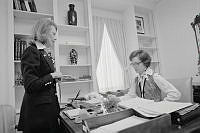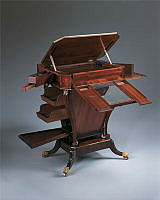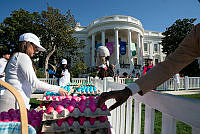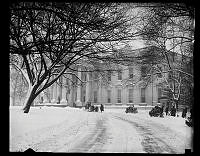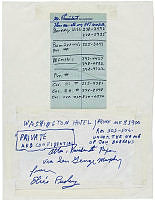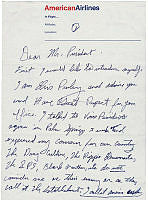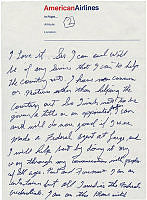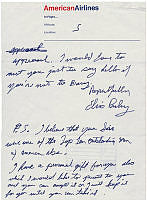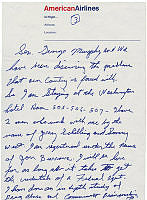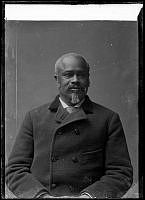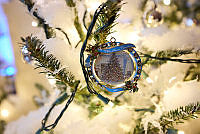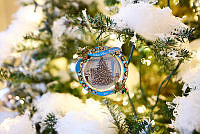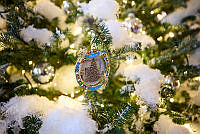Rubenstein Center Scholarship
“A Place of Peace”
George Cortelyou and the Early 20th-Century White House

George Bruce Cortelyou as Secretary of the Treasury, c. 1907-09.
Library of Congress“He is an organizer, a methodizer, a man of decision, a judge of values, and above all he knows the worth of time,” wrote author Elbert Hubbard of George Bruce Cortelyou (1862-1940), whose mastery of many practical administrative matters and his ability to keep up with an enormous stream of paperwork made him the forerunner of today’s White House chiefs of staff, communications directors, and appointment secretaries.1
Born in New York City, Cortelyou wavered between the studies of music and the law; law won out and Cortelyou later mastered shorthand. He later earned $2.75 a day as a stenographer and his efficiency caught the attention of Fourth Assistant Postmaster General Robert A. Maxwell, who recommended him to President Grover Cleveland, who had been searching for a chief clerk.
When Cortelyou reported for work he told Cleveland, “I don’t want to be here on false pretenses, Mr. President, and I think you ought to know my politics. I’m a Republican.” “I don’t care a d—n about your politics,” Cleveland replied. “There are no politics in confidential relations.”2 Cleveland was so impressed by Cortelyou’s work that when he left office in 1897 he confided to his successor, William McKinley, “If you want things to run smoothly around here, my advice is to keep Cortelyou.”3

George Bruce Cortelyou can be seen just to the right of President William McKinley as McKinley shakes hands from the rear platform of a train in Alliance, Ohio, c. 1900. Agriculture secretary James Wilson and Interior secretary Ethan Hitchcock are also aboard.
Library of CongressDuring McKinley’s first term Cortelyou stepped into a vacuum left by the ineffective John Addison Porter, who had the official title of McKinley’s secretary. When Porter resigned in April 1900, Cortelyou replaced him. In 1901, Cortelyou went with McKinley for a series of appearances at the Pan-American Exposition in Buffalo and was standing just to McKinley’s right when the president was mortally wounded by an assassin. As McKinley fell backward Cortelyou caught him in his arms and heard the president say, “My wife . . . be careful, Cortelyou, how you tell her. Oh, be careful.”4
When Theodore Roosevelt moved into the White House following McKinley’s death, he asked Cortelyou to put the presidential office on a rationally organized business basis. Cortelyou promptly developed a code of behavior for the White House clerks, doorkeepers, messengers, police officers, secretaries, and ushers.5 Cortelyou also established systems for the formerly often-chaotic and disorganized railroad trips taken by the president by writing a book of instructions with comprehensive preparation for the tours.6
As presidential gatekeeper, Cortelyou sifted through letters and telegrams from people asking for an appointment with the president. If Cortelyou thought the request might create a political headache for his boss, he asked for more details about why the person wanted a meeting; “submit a written statement of the matter which you desire to bring to his notice.”7
Cortelyou met with reporters, who regularly covered the White House, twice a day to ensure the Roosevelt administration could put across its spin on the news and earn favorable public opinion. Cortelyou also began the use of the press release and the release of the president’s major speeches and State of the Union addresses to let the outside world know about the president’s actions and thinking, and also was among the first presidential aides to analyze newspaper and magazine articles to measure the public’s reaction to the president’s policies.8

A 1904 cartoon in Puck magazine compared Cortelyou, then chair of the Republican National Committee, to Sisyphus as he tried to secure President Theodore Roosevelt’s election to a full term.
Library of CongressMindful of the experience of the Spanish-American War when news broke all week, Cortelyou started Sunday hours from 10:00 a.m. to 4:00 p.m. in the White House executive offices so that staff would be present if an emergency happened, and staff members also assumed night duty on a rotating basis. Cortelyou disliked having cluttered piles of crumpled papers and messages piled up in the Executive Offices and demanded that at the end of the day all desks were to be completely clear.9
After McKinley’s assassination, Cortelyou realized that the president’s personal security needed to be brought more in line with contemporary realities. With Roosevelt’s approval, Cortelyou met in October 1901 with officials from the Secret Service, the Washington D.C. police, and the U.S. postal inspectors to set up a strategy to guard the president. They agreed to seek increased congressional appropriations for the Secret Service, raise the number of police guards on the White House grounds, double the number of Secret Service agents in the president’s office at all times from one to two, and enlarge the number of agents who accompanied the president on journeys outside Washington. The postal inspectors would monitor threatening letters to the president and keep the White House and law enforcement informed if the chief executive planned to visit a town or city where a potentially ominous piece of mail had originated.10

Cortelyou, his wife, Lily, and daughter, Grace, arrive at the Theodore and Edith Roosevelt home in Oyster Bay, Long Island, for the wedding of the former president’s daughter Ethel, April 1913.
Library of CongressAlthough Cortelyou would go on to serve as Roosevelt’s Secretary of Commerce and Labor, Postmaster General, and Secretary of the Treasury, his greatest contributions in public life were to modernize the management of the White House executive offices so it would be prepared to meet the challenges of the 20th century. In 1908, James Creelman wrote that Cortelyou had “saved the president from a thousand annoyances and delays by the exercise of tact and patience . . . His common-sense, sobriety, gentleness and orderly industry made the White House a place of peace.”11





